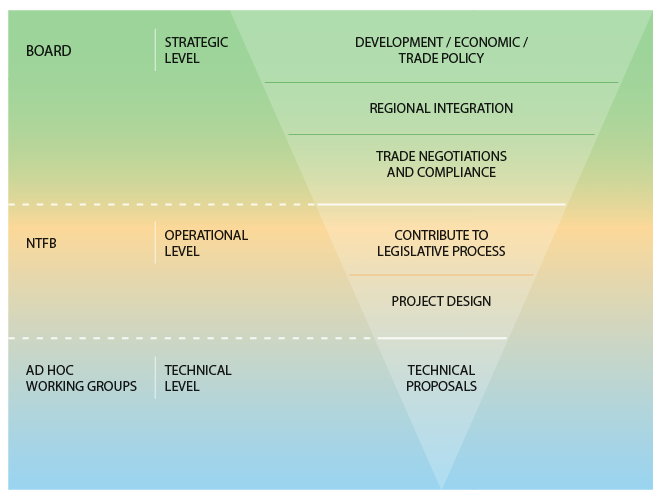Step 2. Learn what the benefits of stakeholder collaboration are and understand the function and objectives of an NTFB.
Benefits of whole of government approach
There are many reasons for working across organizational boundaries and engaging with the private sector. Not least that trade facilitation does not fall into the portfolio of one line ministry or government agencies. It cuts across many fields of national legislation and government responsibilities. Some implementation solutions require active sharing of information, i.e. for risk management between central and regional level or between agencies, some even rest on sharing of infrastructure and equipment i.e for coordinated border agency intervention. In other areas, efficiency gains are higher through sharing services, such as IT services of a Single Window or Internet for publication.
Formal coordination bodies offer a platform for dialogue and decision-making. A regular platform for dialogue creates trust, which is the basis for a partnership between government agencies and traders that can lead to simplification measures introduced as a reward to compliant traders. An inclusive decision-making process ensures that decisions are based upon the best articulation of the challenges and imperatives faced, an open assessment of the different possible approaches, and that a broad range of stakeholder views’ are heard.

Levels of engagement
To fulfill this role a NTFB commonly has to get engaged at different levels-as shown in the illustration above.
At the strategic level to link trade facilitation with the development and economic policy goals as well as the objective of regional integration; at this level it will get engaged in formulating strategies, and bilateral, regional and multilateral negotiations that have a bearing on trade facilitation.
On the operational level, a trade facilitation body will contribute to national policy making. It may be tasked to develop or contribute to the legislative process or may provide opinion papers and awareness meetings on existing proposals.
On the technical level, a NTFB may be involved in developing or overseeing implementation projects, as well as drafting technical proposals and standards.
Objectives and purpose
The concrete objectives and functions assigned to a NTFB vary from country to country and are commonly regulated in the mandate and/or Terms of reference for such a body. The general objective is to act as an open forum to promote trade facilitation, facilitate inter-agency coordination, and provide directives on major trade facilitation issues. There are a number of specific purposes or objectives that guide the activities of the NTFB. According to the UN/CEFACT Rec. No 4, these specific objectives can be grouped into facilitation objectives, regulatory objectives, development objectives, capacity building objectives, and negotiations objectives. They can be formulated as follows:
- Provide a national forum equipped with a consultation mechanism for the facilitation of formalities, procedures and documentation used in international trade, multimodal transport, transit, logistics, finance and other related areas (facilitation objectives);
- Propose, for government approval, draft trade-related regulations and practices in the areas mentioned in the previous bullet point (regulatory objectives);
- Make policy recommendations on future trade-related investments (development objectives);
- Increase awareness of the methods and benefits of trade facilitation (outreach and capacity building); and
- Support trade facilitation negotiations at bilateral, regional and multilateral levels (negotiations objectives).
For more details on these objectives, consult the Annex of the UN/CEFACT Recommendation No. 4
The functions and objectives attributed to the NTFB dictates the organisational set up . Without prescribing to a single set up, there are specific organisational issues that need to be addressed.
